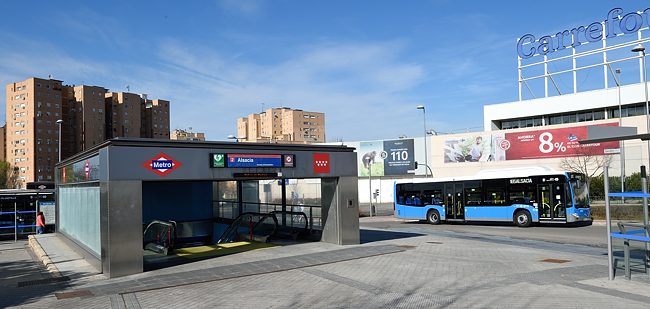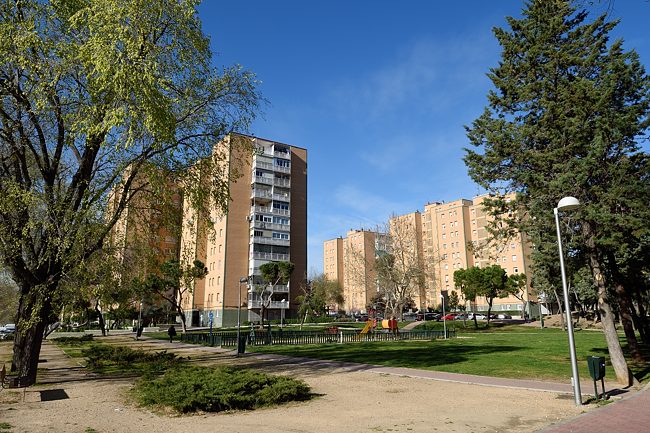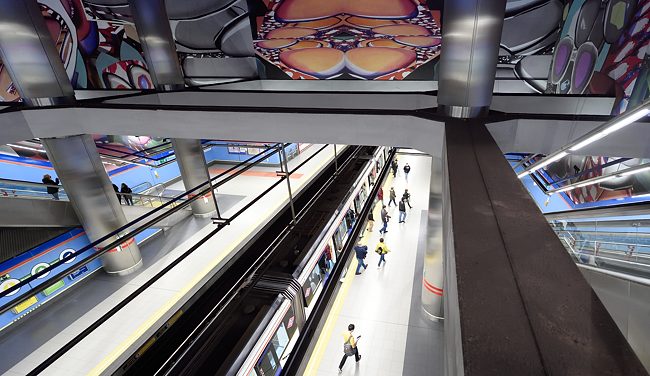The blue-shirted innocent at lower right above is about to enter Madrid’s Alsacia station: second to the last on the eastern end of the metro 2 line, in the city’s un-touristy outskirts. Alsacia straphangers can expect weekday subways every three to five minutes for a twenty-six minute shlep to the Sol transit hub in Madrid’s center.
A bedroom community. I met a friend here last winter, spent an afternoon strolling among and around these butterscotch high-rises, nagged myself afterward to return with my camera.
Why?

I judge this housing as representative of transit-oriented residential development in Madrid. Maybe a few notches up from the mean, but representative. A visitor can pass many, many acres of similar housing in the city’s afueras: high-rise, high-density complexes that can feed armies of potential riders to a heavy rail transit artery, that can’t make financial sense without lots of traffic.
Spain cities grew vertically. Journalists here have told the story: in elDiario, in El País, and in an El Confidencial article recounting the post-Civil War flood of campesinos into the capital. (In 1957, Madrid even required new arrivals to show proof of housing. Madrid had to grow.)

U.S. cities like Los Angeles, in contrast, didn’t grow vertically. (Which may be for the best long-term in L.A., given the region’s notorious earthquake risks.) The only similar residential development that comes to mind in L.A. is Park La Brea.
Books are available to explain why and how Los Angeles grew as it did, but I’m afraid they won’t help Angelenos concerned about SoCal mobility today. If Dad’s in a coma ’cause Cuddles the Hippo trampled his head at the zoo, his bereaved offspring won’t rouse him by learning how Cuddles got out of her enclosure. The lawyers will want to know, and the zoo will, but the knowledge won’t help family members. What’s done is done. Land use patterns in mature cities like Los Angeles and Madrid are a mostly done deal.

I have thumped the drum about similar themes in many posts past, but feel I neglected it in my ‘Ode to the Madrid Metro’ missive. Hence, this entry. This blog is called transitophile, after all.
The Alsacia metro station belongs to the outskirts of the Arcos barrio in Madrid’s San Blas-Canillejas district. An internauta wielding a mouse in Google Maps Street View will find a variety of high-density housing in Arcos, some as attractive as this, some significantly worse.
But, everyone gets a nice metro station. Not a Prado-ready work of art, but clean, functional, maintained. Nice, or at least nice enough.
Photo directory: https://transitophile.com/chango/files/alsacia/

I would love to find such a place to retire. Transit here in freeway land is a sad joke,
the only hope is automated electric taxis. Though I heard of a place in Alaska where
a whole town is in a single high-rise building, which helps with the bear problem.
Idealista.com lists Spain properties … but the only bear I know of in Madrid is this guy:
https://en.wikipedia.org/wiki/Statue_of_the_Bear_and_the_Strawberry_Tree